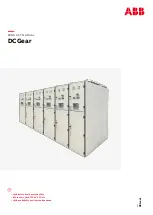
9365200990 Rev F
BE1-CDS240 Reporting and Alarm Functions
6-11
Setting the Load Profile Recording Function
For the load profile recording function to log data, you must set the demand logging interval. This can be
done from the ASCII command interface using the SG-LOG (setting general, logging interval). Table 6-6
lists the settings for the optional load profile recording.
Table 6-6. Load Profile Recording Settings
Function
Range
Increment
Unit of Measure
Default
Demand Log Interval
1 – 60
1
Minutes
15
Retrieving the Load Profile Recording Function
Load profile recorded data is reported by the ASCII command interface using the RD-LOG command.
You may request the entire log or only a specific number of entries.
DIFFERENTIAL CURRENT MONITORING FUNCTION
Differential current monitoring is a diagnostic function designed to aid in the installation and
commissioning of transformer banks. This function attempts to identify and prevent false trips due to
incorrect polarity, incorrect angle compensation, or mismatch.
During transformer commissioning, it would be particularly useful to analyze the system installation and
create a record of the settings and measured currents. The differential current monitoring function can
create a differential check record like the sample shown in the following paragraphs. These records are
also useful when comparing the present system characteristics to the characteristics at commissioning. A
differential record is generated automatically when the ASCII interface command RA-DIFF=TRIG (report
alarm-differential, trigger) is issued or when a differential alarm is set. When no alarms are active, you
must use the RA-DIFF=TRIG command to obtain a record of the actual operating conditions.
The following differential check record example was developed from a simulated substation and shows
that there are no problems in the installation or settings. The first part of the record is the date and time
the record was captured and the basic relay identification.
The second part is a record of the CT connections and 87 (differential) settings. These settings may be
entered using the S<g>-87 command. Refer to Section 3,
Input and Output Functions,
and Section 4,
Protection and Control, Differential Protection,
for more information on entering settings that develop both
the second and third parts of the record. Also, refer to Section 3,
Input and Output Functions,
for
information on the CT polarity convention used in both the fourth and fifth parts of the record.
The third part is a record of the compensation factors. It is important to note that the angle compensation
cannot be entered manually. The angle compensation is calculated by the relay based on the CT and
transformer connections. (See Section 3
, Input and Output Functions, Power system Inputs, Power
Measurement, Setting Up the Power System Measurement Functions,
for more information on
automatically determining compensation.) Additionally, the tap compensation setting may be entered
manually or automatically calculated. (See Section 4,
Protection and Control, Differential Protection,
for
more information on auto-tap compensation.)
The fourth part of the record attempts to identify polarity and angle compensation errors by looking at the
phase angle differences of compared phases. The differential alarm is set whenever the minimum pickup
or the slope ratio exceeds the differential alarm, percent of trip setting. If the differential alarm is set and
neither the polarity alarm nor angle compensation alarm is set, a mismatch error is identified indicating
that the most likely cause of the alarm is incorrect tap settings. The differential check record needs a
specific amount of secondary current to properly measure phase angles. In 5-ampere relays, that amount
of current is 150 milliamperes. In one-ampere relays, it is 30 milliamperes. If there is not enough current
present to run the algorithm, the message
I < 150 ma
(or 30 ma) appears in the appropriate alarm
column. Since all phase angles are referenced to A1, no current applied to A1 will cause the
I < 150
ma
(or 30 ma) message to appear for all phases.
The fifth part (MEASUREMENTS) displays the measured and calculated currents at the time of the
differential record trigger. The relay measures secondary current and develops the tap compensated
currents for use by the differential element. Primary current (
MEASURED I PRI
) is calculated simply as
the secondary current multiplied by the CT turns ratio. Secondary current (
MEASURED I SEC
) is the
current actually measured by the relay. Angle compensated current (
ANGLE COMPENSATED I
) is the
Summary of Contents for BE1-CDS240
Page 2: ......
Page 8: ...vi BE1 CDS240 Introduction 9365200990 Rev F This page intentionally left blank ...
Page 38: ...1 28 BE1 CDS240 General Information 9365200990 Rev F This page intentionally left blank ...
Page 40: ...ii BE1 CDS240 Quick Start 9365200990 Rev F This page intentionally left blank ...
Page 152: ...ii BE1 CDS240 Metering 9365200990 Rev F This page intentionally left blank ...
Page 226: ...iv BE1 CDS240 Application 9365200990 Rev F This page intentionally left blank ...
Page 286: ...ii BE1 CDS240 Security 9365200990 Rev F This page intentionally left blank ...
Page 290: ...9 4 BE1 CDS240 Security 9365200990 Rev F This page intentionally left blank ...
Page 292: ...ii BE1 CDS240 Human Machine Interface 9365200990 Rev F This page intentionally left blank ...
Page 306: ...10 14 BE1 CDS240 Human Machine Interface 9365200990 Rev F This page intentionally left blank ...
Page 308: ...ii BE1 CDS240 ASCII Command Interface 9365200990 Rev F This page intentionally left blank ...
Page 342: ...11 34 BE1 CDS240 ASCII Command Interface 9365200990 Rev F This page intentionally left blank ...
Page 349: ...Figure 12 5 Horizontal Rack Mount Front View 9365200990 Rev F BE1 CDS240 Installation 12 5 ...
Page 361: ...Figure 12 17 Typical DC Connection Diagrams 9365200990 Rev F BE1 CDS240 Installation 12 17 ...
Page 372: ...12 28 BE1 CDS240 Installation 9365200990 Rev F This page intentionally left blank ...
Page 468: ...13 92 BE1 CDS240 Testing and Maintenance 9365200990 Rev F This page intentionally left blank ...
Page 512: ...14 42 BE1 CDS240 BESTCOMS Software 9365200990 Rev F This page intentionally left blank ...
Page 544: ...ii BE1 CDS240 Terminal Communication 9365200990 Rev F This page intentionally left blank ...
Page 550: ...ii BE1 CDS240 Settings Calculations 9365200990 Rev F This page intentionally left blank ...
Page 578: ...D 28 BE1 CDS240 Settings Calculations 9365200990 Rev F This page intentionally left blank ...
Page 579: ......
















































